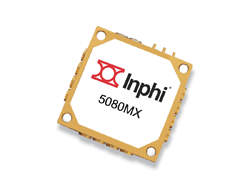High-speed serializers move data at up to 50 Gbits/s
Fast data bus conversion to serial stream is a modern system necessity
BY ROBERT SCHWANKE
Inphi
Westlake Village, CA
http://www.inphicorp.com
in many of today’s high-capacity processing systems, wide parallel buses are converted to high-speed serial signals for easy transport across boards or cables. High-speed serial signaling standards along with proprietary implementations have become a vital necessity in video, computing, telecommunications, data communications, satellite, military, and aerospace applications.
A parallel-to-serial converter, often referred to as a multiplexer or serializer, can be used to convert a 16-bit-wide parallel data bus, usually from an ASIC or FPGA, into a single, serial-bit signal. Using this topology, a 64-bit data bus can be channelized into four high-speed serial signals or a 128 bit data bus can be channelized into eight. The serialized signals, or channels, can then be transmitted across a densely packed PCB, over a chassis back plane, through a fiber optic cable, or through free space via a satellite, microwave, or free-space optics link.
The push for increasing capacity
While the use of channelized data buses is extremely advantageous, newer systems continue to push the need for ever increasing capacity. To meet this need serial signals must operate at data rates of 20, or even 50 Gbits/s. Along with these high data rates comes the requirement to perform protocol testing. This requires a broadband, ultra-high-speed, multi-channel pattern generator. Such serializers are now available.
Existing parallel-to-serial converters made with traditional gallium arsenide (GaAs), silicon CMOS, and silicon germanium (SiGe) technologies typically have a data rates of only 1 to 10 Gbits/s and often include narrowband clock multiplier circuits. Today, however, 4:1 serializers made from commercially available Indium Phosphide (InP) technology that has been qualified for use in military applications and tested to be radiation tolerant, meet the exacting needs of designers working on test and measurement, high-performance communications like the new 100GE standard, video, computation, and R and D. The high performance and unique characteristics found in InP technology translates into devices that are well suited for use in most industries and offers a significant increase in serial link capacity.

Fig. 1. This 16:1 parallel-to-serial converter circuit operates at up to 50 Gbits/s.
16:1 serializer circuit implementation
The 16:1 parallel-to-serial circuit can be implemented using four low-level 4:1 serializers and one high-level 4:1 serializer (see Fig. 1). The 16 inputs of the four low-level serializers are the low-speed data inputs. The four high-speed data outputs from these serializers feed into data inputs of the high-level 4:1 device and the data output from it will be the serialized high-speed channel. A full rate, high-speed clock is needed to drive the high-level 4:1 serializer and a divide-by-four creates the lower speed clock for the other devices. And, the low-speed divide-by-four clock outputs of the low-level 4:1 serializers can be used for synchronization and to clock the upstream device (ASIC or FPGA) that generates the input data lines.
The characteristics required for a good multi-gigabit/s serializer are broadband operation, 300 degrees or more of clock phase margin, and robust differential CML I/O buffers with low added jitter and fast edge rates. A simple, straightforward architecture is key when using parallel-to-serial converters as building blocks in broadband applications that require signal faster than a few gigahertz.

Fig. 2. An example 2080MX data eye demonstrates signal quality at 12.5 Gbits/s.
Figure 2 shows an example of a high-quality data eye at 25 Gbits/s as can be obtained from parallel-to-serial converters made from InP. InP has an inherent speed advantage and routinely outperform circuits made in GaAs and SiGe.
Example ICs using Indium Phosphide come from Inphi (www.inphicorp.com). The 2080MX (20 Gbits/s) and 5080MX (50 Gbits/s) 4:1 P/S converters and 20709SE (20 Gbits/s) 2:1 selector/mux, offer system designers attractive solutions to boost the capacity of high-speed serial links—making for higher performance, and often more cost-effective, systems.■

Fig. 3. The 5080MX 4:1 multiplexer IC supports input data rates up to 50 Gbits/s and requires only 1.5 W typ.
For more information and articles on Digital ICs go to www.electronicproducts.com/digital.asp
Advertisement
Learn more about Inphi





